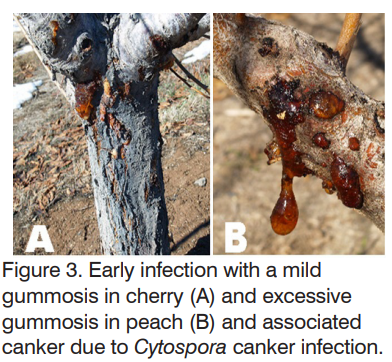Cytospora Canker affecting Western Slope Peach Growers
- 2018-07-18
- By Drew Walters
- Posted in Agriculture, Horticulture
Cytospora Canker is a fungal pathogen that impacts many hardwoods in North America, and is becoming a major concern for peach growers in Colorado.
A variety of the fungus will infect stone fruits (like peaches, cherries, and apricots) with spores that enter the tree through a wound (like a cut/scratch or limb injury on a tree). Stressed trees are most susceptible to infection. After being introduced into the tree, it causes cankers which will eventually girdle the trunk, killing branches and eventually the tree itself (depending on severity).
Symptoms of Cytospora Canker appear as a wound in the bark which seeps sticky sap (also known as Gummosis). This disease is widespread in North America, but it is of particular importance in Colorado (due to reduced use of preventative fungicide use in orchards, when compared to states with higher fungal problems due to a greater volume of rainfall). Additional factors that aid in the spread of this disease can be a result of abandoned orchards and stone fruit trees in small acreages (which are not actively being managed by fungicide applications).
Because pruning cuts can act as an easy entry-point for diseases, proper timing and technique plays a major role in preventing and managing diseases. Winter pruning (a common practice for woody plants) can be a factor in the increased spread of this disease- because the dormant tree is not producing any defenses against pathogen. The most vulnerable time for pruning these trees is from March through June (when the fungal presence is very high in the environment).
CSU Extension pruning techniques and recommendations:
- Vertical or Slant cuts are recommended (because horizontal cuts hold more moisture and spores, and can increase the likelihood of fungal infection).
- Pruning should be delayed to as late as possible in the growing season (but prior to late fall when trees begin to harden-off and prepare for winter dormancy).
- Avoid pruning during times of high humidity (such as rainy or snowy weather) because these conditions promote fungal presence and spread.
- Horizontal cuts flush with the branch increase the likelihood of an infection to spread more rapidly, and girdle the tree. (Leaving short 2-3 inch stubs of wood during a prune will minimize the risk of a rapidly girdling fungus.
- Applying a pruning spray or tree paint immediately after pruning will also reduce the likelihood of fungal inoculation into the tree.
As always, proper sanitation of tools (such as saws, clippers, shears, cutters, and pruners) will minimize the transfer of pathogens from infected to healthy trees. Sanitize your tools after each tree, using alcohol, and dispose of pruned material (especially diseased material) properly, and DO NOT re-introduce this waste into the area as mulch or compost. Fungal spores can survive and reproduce in dead branches, and this can result in repeat infections, and continual disease spread. Brush piles should also be managed regularly and disposed of regularly (to prevent an additional source of spores). Irrigating frequently, and for shorter time intervals is also recommended (because prolonged moisture on plant surfaces also increases fungal risk).

Cytospora Canker on Peach Tree showing signs of sap response, known as “Gummosis”. (CSUE)
For more information on Cytospora Canker:
http://extension.colostate.edu/docs/pubs/crops/02953.pdf
Please visit our new GarCo Extension Website and Blog!
URL: https://garcogardening.weebly.com/

